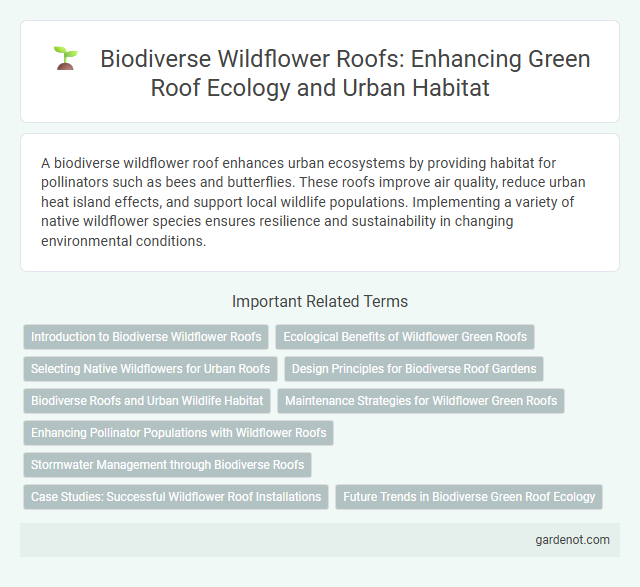A biodiverse wildflower roof enhances urban ecosystems by providing habitat for pollinators such as bees and butterflies. These roofs improve air quality, reduce urban heat island effects, and support local wildlife populations. Implementing a variety of native wildflower species ensures resilience and sustainability in changing environmental conditions.
Introduction to Biodiverse Wildflower Roofs
Biodiverse wildflower roofs promote urban ecology by supporting native pollinators and enhancing habitat variety. These green roofs consist of carefully selected wildflower species adapted to local climates, providing seasonal blooms that attract bees, butterflies, and other wildlife. Incorporating a biodiverse wildflower roof improves air quality, aids stormwater management, and increases urban resilience against climate change.
Ecological Benefits of Wildflower Green Roofs
Biodiverse wildflower green roofs support urban ecosystems by providing essential habitats for pollinators such as bees and butterflies. These roofs enhance air quality and reduce the urban heat island effect through increased vegetation cover and evapotranspiration. By promoting native plant diversity, wildflower green roofs improve soil health and contribute to stormwater management, mitigating runoff and reducing flooding risks.
Selecting Native Wildflowers for Urban Roofs
Selecting native wildflowers for biodiverse green roofs enhances ecological resilience and supports local pollinators by providing habitat and food sources. Native species such as Echinacea purpurea, Solidago canadensis, and Asclepias tuberosa thrive in urban rooftop conditions due to their adaptability to local climate and soil. Incorporating these wildflowers fosters biodiversity, improves stormwater management, and contributes to urban heat island mitigation.
Design Principles for Biodiverse Roof Gardens
Biodiverse wildflower roofs incorporate native plant species that support local wildlife and enhance urban ecosystems. Design principles emphasize soil depth tailored to diverse plant requirements, incorporation of varied microhabitats, and ensuring structural support for ecological functionality. Integration of stormwater management and maintenance plans fosters long-term biodiversity sustainability on green roofs.
Biodiverse Roofs and Urban Wildlife Habitat
Biodiverse wildflower roofs enhance urban ecosystems by providing critical habitats for pollinators, birds, and insects, supporting over 150 species in a single square meter. These green roofs improve air quality, reduce urban heat island effects, and increase stormwater retention by up to 40%. Incorporating native wildflowers promotes ecological resilience and biodiversity, transforming urban rooftops into thriving wildlife sanctuaries.
Maintenance Strategies for Wildflower Green Roofs
Effective maintenance strategies for biodiverse wildflower green roofs prioritize seasonal inspections and selective weeding to support native flora diversity. Incorporating adaptive irrigation methods ensures optimal moisture levels without waterlogging, promoting robust plant growth and soil health. Monitoring plant species composition regularly helps maintain ecological balance, preventing invasive species dominance and enhancing pollinator habitats.
Enhancing Pollinator Populations with Wildflower Roofs
Biodiverse wildflower roofs provide critical habitats that support and enhance pollinator populations by offering a variety of native flowering plants throughout the growing season. These green roofs increase floral diversity, boosting nectar and pollen availability for bees, butterflies, and other pollinators essential for urban ecosystem health. Incorporating wildflower roofs in urban planning promotes biodiversity, improves pollination services, and contributes to resilient green infrastructure.
Stormwater Management through Biodiverse Roofs
Biodiverse wildflower roofs enhance stormwater management by increasing rainwater retention and reducing runoff through natural absorption and evapotranspiration. These roofs support diverse plant species that improve soil structure and promote infiltration, mitigating urban flooding and decreasing pressure on drainage systems. Incorporating native wildflowers fosters resilient ecosystems, contributing to sustainable stormwater solutions in urban environments.
Case Studies: Successful Wildflower Roof Installations
Case studies of biodiverse wildflower roofs highlight successful installations in urban areas where native plant species thrived, enhancing local ecosystems. Projects in cities like London and Berlin demonstrated increased pollinator activity and improved air quality, showcasing the environmental benefits of these living roofs. Data from these installations reveal significant rainwater retention and temperature regulation, confirming their role in sustainable urban development.
Future Trends in Biodiverse Green Roof Ecology
Biodiverse wildflower roofs are increasingly recognized for their role in enhancing urban ecosystems by supporting pollinator populations and improving air quality. Future trends indicate a shift towards integrating native plant species that adapt to microclimates, boosting ecological resilience and promoting habitat connectivity in dense urban areas. Advances in substrate technology and climate-adaptive plant selection are set to optimize water retention and nutrient cycling on green roofs, fostering sustainable and self-sustaining ecosystems.
Biodiverse wildflower roof Infographic

 gardenot.com
gardenot.com